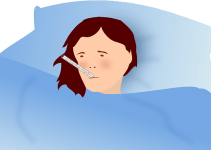Vitex is a plant that has been used as herbal medicine for centuries. It was believed to curb sexual appetite, which explains the alternative name chaste tree.
In fact, ancient Roman women used the plant as bedding to inhibit lust during Thesmophoria, a festival where wives leave home in order to remain chaste.
There have been claims of the plant being used as anti-libido medicine by monks, hence the other name for it: monk’s pepper.
These days, Vitex is mainly used as a medication for the management of premenstrual stress syndrome (PMS) and cyclical breast pain (mastalgia) as well as an herb promoting fertility.
About Vitex
Vitex is a family of plants that grow in temperate and tropical climates. The one used for medicinal purposes is called Vitex agnus-castus (VAC).
It is believed to regulate the pituitary gland, which is responsible for controlling many of the body’s functions, like telling the ovaries what quantity of hormones to produce.
The leaves, stem, flowers, and seeds are harvested for use as alternative medicine. William Tuner, a 16th-century English herbalist, reported about the anaphrodisiac properties of the Vitex seed when they are fried and not fried.
In The Flower and the Leaf, Chaucer refers to the plant as an attribute of Diana, a goddess known for her chastity.

Effectiveness
Although several instances from the past connect Vitex with curbing sexual desires, there is no concrete evidence proving so.
What it does have, however, are clinical studies discussing how effective it has been as medication, particularly when it comes to fertility issues as well as problems women face during their periods.
Several studies have discussed the effectiveness of Vitex as medication. One showed that fruit extracts from the Vitex plant bind to opiate receptors, which helps explain why it can minimize discomfort during PMS.
Others have shown that Vitex stimulates and stabilizes reproductive hormones needed for ovulation, regular menstruation, and cycle balance.
Here are other results of Vitex studies:
It limits the chances of mild endometriosis from advancing. In Germany, gynecologists use Vitex as a treatment for mild endometriosis. In addition, it’s also used to prevent the condition from becoming worse.
It solves amenorrhea. Amenorrhea is the lack of menstruation, and a study showed that Vitex solved the issue. Sixty-five percent of the women who took the medication had their menstrual cycle restored by the time they’ve been using Vitex for six months. They also experienced increased levels of progesterone.
It reduces uterine cysts. Studies have shown that taking Vitex has lessened the cysts growing in the uterus’ smooth muscle layer.
It stimulates milk production. This is true, particularly with new mothers. This was one of the purposes for taking Vitex during ancient times and the same holds true today. New mothers who took Vitex after birth and for ten days after experienced increased milk production.
It improves acne. There are studies that have shown taking Vitex can improve the skin. However, in order for this to be effective, a change in one’s diet is required.
Dosage
Vitex is taken orally to help with irregularities in the menstrual cycle, PMS, premenstrual dysphoric disorder (a more severe form of PMS) and menopausal symptoms. VAC has also been used to treat fibrocystic breasts, control bleeding and increase breast milk.
The suggested dose for Vitex is once a day, preferably in the morning, on an empty stomach. For the best results, it should be taken for an entire month without any breaks.
It also comes in many forms, such as capsules, powder, tea, tincture, and loose herbs, but the results are best when taken in capsule and tincture form. Why is that the case? It is so much easier to control the dosage that way.
Side Effects
Vitex has been used since ancient times and not many side effects have been reported. However, that doesn’t mean there aren’t any.
Then again, the percentage of those who reported symptoms range in the 1 to 2% and the issues they felt were headaches, nausea, gastrointestinal upsets, and skin reactions.
The worsening of depressive symptoms has also been reported among other women who take Vitex to aid with menstrual irregularity.
Since there is limited research concerning the use of Vitex and oral contraceptives, it’s best to not use these two together.
In particular, it’s not a good idea to mix Vitex with prescription medication containing hormones, as it may affect what those are trying to do.
Another side effect of using Vitex is a shift in the menstrual cycle. Put simply, it may take a while for the cycle to stabilize.
When first taking Vitex, some women will experience a shorter cycle while some will have a longer cycle. This is fine, as it’s just the body’s way of adjusting.
Vitex and Fertility
To understand the connection between Vitex and fertility, it helps to first understand female fertility. Women need to have a regular menstrual cycle if they want to get pregnant. In order for this to happen, there must be a hormonal balance.
This means there should be a healthy balance of estrogen and progesterone, two reproductive hormones that get the body ready for ovulation and ensure pregnancy is maintained.
Where does Vitex fit in? It regulates hormones and menstrual balance, thereby increasing fertility.
The pituitary gland is responsible for major body functions and that is where Vitex goes to work. This gland secretes hormones or sends the signals to start the production of reproductive hormones.
Two hormones are produced in the gland: luteinizing hormone (LH) and follicle stimulating hormone (FSH). Both work together during the menstrual cycle.
The ovarian follicle produces estrogen and progesterone. A rise in estrogen levels signals the pituitary gland to stop making FSH and focus on making more LH. This shift results in the release of an egg from the ovary, a process called ovulation.
The empty follicle where the egg was released now becomes the corpus luteum, which releases progesterone necessary for maintaining pregnancy.
A number of infertility issues can be traced back to insufficient production of progesterone during the luteal phase, the second half of the menstrual cycle that follows ovulation. This is where Vitex comes in to help by making sure there is enough progesterone during the luteal phase.
Clinical studies have proven the effectiveness of Vitex in improving fertility. One study showed improved progesterone levels in the luteal phase for 67 women with fertility disorders; 38 of those women achieved pregnancy.
Vitex for PMS and Period Problems
Vitex is a prescribed medication in Germany for those who suffer from PMS. As mentioned earlier, a study revealed that VAC extracts bind to opiate receptors, therefore reducing any discomfort associated with PMS.
Among the PMS symptoms, Vitex can alleviate are breast pain, fluid retention, and irritability.
Those who suffer from irregular periods can take Vitex to correct the issue. Vitex is vital in promoting ovulation and a period can result within two to three months of taking it. However, this will not be the case for everyone.
For instance, it might make things worse for those with polycystic ovary syndrome (PCOS), some of whom already have increased levels of LH (a hormone which may rise if Vitex is taken).
However, not everyone believes in the effectiveness of Vitex to treat PMS and period problems. There were cases where ladies experienced continuous bleeding for two cycles after being prescribed Vitex.
Several women have also reported changes in their behavior after taking the medication. Some have even reported being depressed. When symptoms like these occur, it’s best to consult with a doctor on the next steps to take.
Not everyone will have the same experiences when taking a particular medication. That or Vitex has interfered with other medication.
Dopamine agonists, such as bromocriptine and levodopa, may interact with Vitex, resulting in increased side effects. To avoid any episodes, always make sure to ask your doctor if Vitex will interact with any other medicines you are taking.
Vitex and Menopause
Vitex has been effective for women who are still in their childbearing years (around 18 years of age to perimenopause). However, there are cases where Vitex loses its effectiveness.
Perimenopause is the stage in a woman’s life leading up to menopause. This usually begins at 40 years of age.
During this period, it is not unusual for ladies to experience irregular menstrual cycles. It’s also a stage where hormones tend to fluctuate. FSH levels will rise when the reserve in the ovaries decline and egg health starts to fade.
Vitex may be used to lower FSH levels as well as ensure regular cycles. However, it may not be recommended for all women.
Aging is a natural process in life, and there is nothing Vitex can do to turn back time. Not every woman responds to medication the same way, either. Some women still in the perimenopause stage might benefit from taking Vitex, while others won’t.
Menopause is the period in a woman’s life when she can no longer reproduce. This can occur to someone in their 40s or 50s. This is a time marked by the end of the menstrual cycle.
As such, women no longer need to worry about pregnancy. This means that Vitex is not at all useful to someone who has undergone menopause, as there are no longer any fertility issues to be solved.
Vitex during Pregnancy
Vitex plays an important role in the improved production of progesterone, which is vital to maintaining pregnancy. Given that fact, is it then safe to take Vitex when someone is pregnant?
Frankly, there is no research to support the safe use of Vitex during pregnancy. However, there was a study conducted on rats that showed no effects whatsoever on the offspring.
A study in Germany also shows that taking Vitex during pregnancy is safe up to the third month. However, Vitex is also believed to stimulate early lactation, so it’s advised to not take it after the third month.
In addition, Vitex may not really be needed during pregnancy given that the job of producing progesterone in the third month is taken over by the placenta.
Vitex is crucial in ensuring pregnancy, and it’s not uncommon for women to want to continue taking it when conception has been confirmed.
That said, a consultation with a doctor must be done before taking the medication. Keep in mind that not every woman reacts to Vitex the same way. It’s always best to ask before taking anything.
Final notes
Vitex has been shown to help with fertility issues and other problems like acne, but it may not work for everyone.
Vitex may interfere with any medication you are taking, so it’s always good to know whether it will affect you or not.




